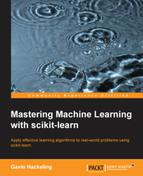Recent years have seen the rise of machine learning, the study of software that learns from experience. While machine learning is a new discipline, it has found many applications. We rely on some of these applications daily; in some cases, their successes have already rendered them mundane. Many other applications have only recently been conceived, and hint at machine learning's potential.
In this book, we will examine several machine learning models and learning algorithms. We will discuss tasks that machine learning is commonly applied to, and learn to measure the performance of machine learning systems. We will work with a popular library for the Python programming language called scikit-learn, which has assembled excellent implementations of many machine learning models and algorithms under a simple yet versatile API.
This book is motivated by two goals:
- Its content should be accessible. The book only assumes familiarity with basic programming and math.
- Its content should be practical. This book offers hands-on examples that readers can adapt to problems in the real world.
Chapter 1, The Fundamentals of Machine Learning, defines machine learning as the study and design of programs that improve their performance of a task by learning from experience. This definition guides the other chapters; in each chapter, we will examine a machine learning model, apply it to a task, and measure its performance.
Chapter 2, Linear Regression, discusses linear regression, a model that relates explanatory variables and model parameters to a continuous response variable. You will learn about cost functions, and use the normal equation to find the parameter values that produce the optimal model.
Chapter 3, Feature Extraction and Preprocessing, describes methods to represent text, images, and categorical variables as features that can be used in machine learning models.
Chapter 4, From Linear Regression to Logistic Regression, discusses generalizing linear regression to support classification tasks. We combine a model called logistic regression with some of the feature engineering techniques from the previous chapter to create a spam filter.
Chapter 5, Nonlinear Classification and Regression with Decision Trees, departs from linear models to discuss classification and regression with models called decision trees. We use an ensemble of decision trees to construct a banner advertisement blocker.
Chapter 6, Clustering with K-Means, introduces unsupervised learning. We examine the k-means algorithm, and combine it with logistic regression to create a semi-supervised photo classifier.
Chapter 7, Dimensionality Reduction with PCA, discusses another unsupervised learning task called dimensionality reduction. We use principal component analysis to visualize high-dimensional data and build a face recognizer.
Chapter 8, The Perceptron, describes an online, binary classifier called the perceptron. The limitations of the perceptron motivate the models described in the final chapters.
Chapter 9, From the Perceptron to Support Vector Machines, discusses efficient nonlinear classification and regression with support vector machines. We use support vector machines to recognize the characters in photographs of street signs.
Chapter 10, From the Perceptron to Artificial Neural Networks, introduces powerful nonlinear models for classification and regression called artificial neural networks. We build a network that can recognize handwritten digits.
